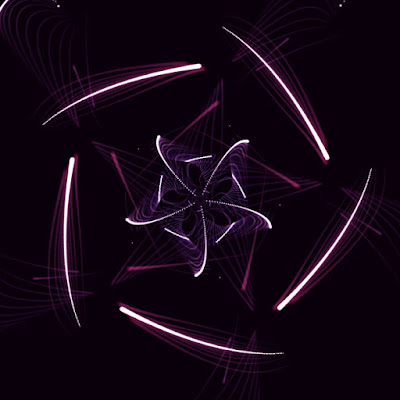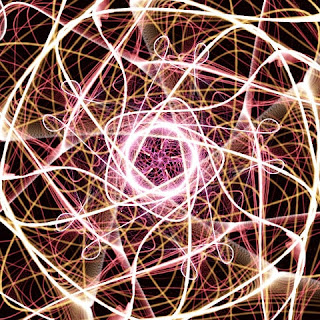Digital art animation of symmetrical flying particles
Making an animation like a kaleidoscope.
It's a digital art animation made with the 'Processing'.
It draws the flying particles in 5 symmetrical. And I made it to animation like a kaleidoscope. It's yet another version of "Teaching Angels How to Fly".
I drew one image and copy it in 5 symmetrical by the 'image()' function. This way is convenient and economical.
A bonus! Without the 'background()' function, it creates beautiful pattern like this.
This code does not display any images on the screen but generates image files in frames directory.
You can make an animation with these files.
The 'Processing' code example.
Please feel free to use this example code under the terms of the GPL.
To see other works based on my code is my pleasure. And my honor.
// Laser Love.
// @author @deconbatch
// @version 0.1
// Processing 3.2.1
// 2018.11.03
void setup() {
size(720, 720);
colorMode(HSB, 360, 100, 100, 100);
blendMode(SCREEN);
imageMode(CENTER);
smooth();
noStroke();
noLoop();
}
void draw() {
int frameCntMax = 15 * 6;
float baseHue = random(360);
float phaseDivBase = random(0.0001, 0.001);
float phaseDivWave = phaseDivBase * random(0.0, 1.0);
translate(width / 2, height / 2);
rotate(random(TWO_PI));
for (int frameCnt = 0; frameCnt < frameCntMax; ++frameCnt) {
float timeDiv = map(frameCnt, 0, frameCntMax, 0.0, TWO_PI); // TWO_PI -> it loops.
PImage imgFlower = pgPattern(timeDiv, phaseDivBase, phaseDivWave, baseHue).get();
background(baseHue + 30.0, 100.0, 5.0, 100.0);
pushMatrix();
for (int i = 0; i < 5; ++i) {
image(imgFlower, 0.0, 0.0);
rotate(TWO_PI / 5.0);
}
popMatrix();
saveFrame("frames/" + String.format("%04d", frameCnt) + ".png");
}
exit();
}
/**
* pgPattern makes PGraphics that is bigger than (width, height).
* You can rotate this PGraphics in (width, height) size canvas without lacking part.
* @param timeBase any : Start time value of recursion formula to determine the drawing shape.
* @param phaseDivBase 0.00001-0.00005 recommend : Increment value of time.
* @param phaseDivWave 0.0-1.0 * phaseDivBase : Rate of change of phaseDivBase.
* @param baseHue 0-360 : Theme color hue value of making PGraphics.
* @return PGraphics with some shape drew on black background.
*/
PGraphics pgPattern(float timeDiv, float phaseDivBase, float phaseDivWave, float baseHue) {
int shapeCntMin = 1;
int shapeCntMax = 5;
PGraphics pg;
pg = createGraphics(floor(width * 1.4), floor(height * 1.4));
pg.beginDraw();
pg.colorMode(HSB, 360, 100, 100, 100);
pg.blendMode(SCREEN);
pg.smooth();
pg.noStroke();
pg.background(0.0, 0.0, 0.0, 100.0);
pg.translate(pg.width / 2.0, pg.height / 2.0);
pg.pushMatrix();
for (int shapeCnt = shapeCntMin; shapeCnt <= shapeCntMax; shapeCnt += 2) {
float shapeRate = map(shapeCnt, shapeCntMin, shapeCntMax, 0.0, 1.0);
float shapeRnd = noise(shapeCnt); // use noise as array of random
int idxTimeMax = 1 * (100 + floor(map(shapeRnd, 0.0, 1.0, -50.0, 50.0)));
int phaseCntMax = 1 * (150 + floor(map(shapeRnd, 0.0, 1.0, -100.0, 100.0)));
pg.rotate(HALF_PI / 20.0);
for (int phaseCnt = 0; phaseCnt < phaseCntMax; ++phaseCnt) {
timeDiv += PI * (phaseDivBase + cos(map(phaseCnt, 0, phaseCntMax, 0.0, PI)) * phaseDivWave);
float prevX = 0.0;
float prevY = 0.0;
float prevT = map(shapeRnd, 0.0, 1.0, -10.0, 10.0);
for (int idxTime = 0; idxTime < idxTimeMax; ++idxTime) {
float x = (pow(sin(prevX), shapeCnt) + cos(prevY)) * sin(prevT);
float y = (pow(cos(prevX), shapeCnt) + sin(prevY)) * cos(prevT);
float t = timeDiv + (x + y) * shapeRnd; // key of this code
float size = map(phaseCnt, 0, phaseCntMax, 1.0, 1.0 + shapeRate * 8.0);
pg.fill(
(baseHue + shapeRate * 60.0 + map(phaseCnt, 0, phaseCntMax, 0.0, 30.0)) % 360,
map(idxTime, 0, idxTimeMax, 80.0, 0.0),
map(phaseCnt, 0, phaseCntMax, 20.0, 0.0),
100
);
pg.ellipse(
x * width * 0.2 * shapeCnt,
y * height * 0.2 * shapeCnt,
size,
size
);
prevX = x;
prevY = y;
prevT = t;
}
}
}
pg.popMatrix();
pg.endDraw();
return pg;
}
/*
Copyright (C) 2018- deconbatch
This program is free software: you can redistribute it and/or modify
it under the terms of the GNU General Public License as published by
the Free Software Foundation; either version 3 of the License, or
(at your option) any later version.
This program is distributed in the hope that it will be useful,
but WITHOUT ANY WARRANTY; without even the implied warranty of
MERCHANTABILITY or FITNESS FOR A PARTICULAR PURPOSE. See the
GNU General Public License for more details.
You should have received a copy of the GNU General Public License
along with this program. If not, see <http://www.gnu.org/licenses/>
*/
Yet another example images with this code.











